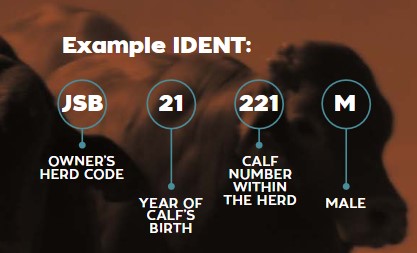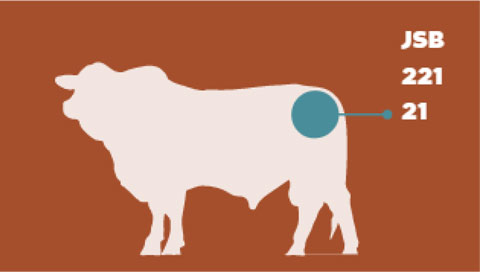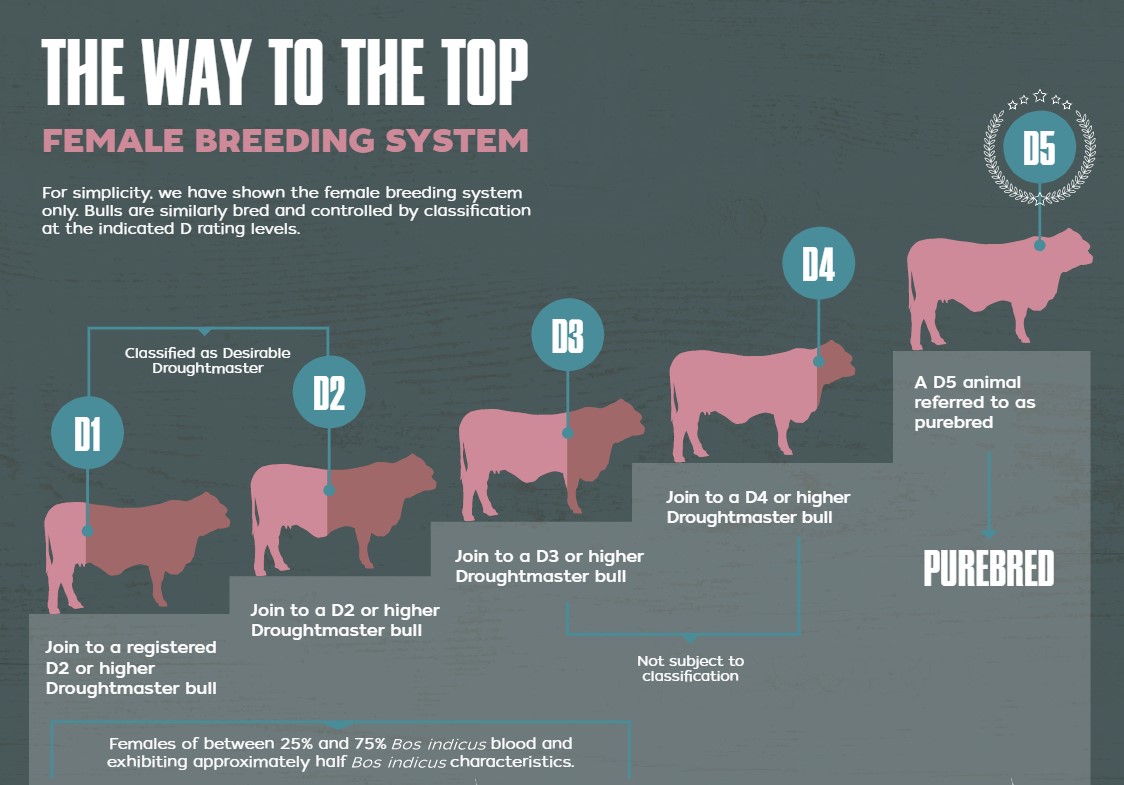All Droughtmaster registered animals are recorded on the DM1 Form and subsequently in the Herd Book by way of a unique identifier, the IDENT.

In many instances, the Stud’s Herd Code and the Owner’s Brand differ, so in some cases, the brand could well feature a symbol brand or a registered alpha-numeric brand such as J6B (J six B). It is not necessary to brand M for male or F for female. The Year Number used depends on whether a stud has nominated to register animals with the Society according to the financial or calendar year. If a stud nominated for Calendar Year recording then every calf born in the 2021 Calendar Year must be recorded as a ‘21’ and likewise every calf born between 1 January 2022 and 31 December 2022 must be an ‘22’ and so on. For studs nominated for Financial Year, calves born between 1 July 2020 and 30 June 2021 will be recorded as a ‘21’ and every calf born between 1 July 2021 and 30 June 2022 will be a ‘22’ and so on. Some studs number consecutively for Calf Number (i.e. they keep the Calf Number rolling on no matter what year number they are using) and others start their Calf Number at ‘1’ each year. From an administrative viewpoint, consecutive or ‘rolling’ Calf Numbers are much better and for that reason, we strongly recommend that the studs adopt this practice if possible. The computer system (ABRI) can handle up to five digits for the Calf Number. If a stud gets into the thousands, then each calf must be branded with the complete Calf Number, not just the last one, two or three digits. Each calf must have a unique Calf Number; you cannot use the same number male and female calf in the same year.
Cattle identification, tracking and tracing via NLIS is a critical aspect of Australia’s beef industry. As the Droughtmaster breed expands and requests for sire and dam verification intensify, accurate animal recognition plays a fundamental role in underpinning genetic success. Branding is not compulsory in all states of Australia. However, irrespective of state regulations, registered Droughtmaster animals must be branded (fire or freeze on the hide) or tattooed (in the ear). Society members generally undertake branding before weaning and it is often incorporated with other standard husbandry procedures, such as castration and dehorning.
Branding Position:
The order or position of these 3 items is up to the individual. Most studs put the brands up high on the rump close to the tail, but ALL parts of the IDENT (except the M for Male or F for female) must be branded on the animal. It is, however, acceptable to use a single digit to depict the year, for example ’21’ can appear in the brand as ‘1’. ALL parts of the IDENT (except the M or F) must still be included if tattooing is used instead of branding.

Pain Management
The Society encourages members to maintain the highest standards of animal welfare and recognises the Australian Animal Welfare Standards and Guidelines for Cattle. Additionally, members should consult with their applicable state authorities to ensure they are meeting legal and suggested local requirements.
The Droughtmaster D System was established to enable breeders to progress their cattle through the system of breeding and inspections by Classifiers to reach purebred or D5 status. The Rules and Regulations of the Society provide the basis of the D System and the requirements outlined therein are mandatory. The System provides an important method of adding or improving desirable characteristics by adding to the gene pool of the original Droughtmaster. This system of personal inspection and classification – in addition to advice and guidance given to breeders – ensures that a standard and uniformity based on the Standard of Excellence for the breed are maintained. The base requirement for D1 females is that they exhibit approximately half characteristics and are between 25% and 75% A key factor is that the D1 and D2 females display tropical coat type, parasite resistance and heat tolerance. The Droughtmaster Standard of Excellence is the basis of all classifications and inspections and both stud breeders and the Classifier have a responsibility to ensure that only those animals that meet the necessary standards are registered or offered for sale. The classification service is restricted to registered members of the Society and a fee can be charged for this service.

Some D-Breeding System FAQs
The progeny will be a D5. Progeny will be a classification of one higher than the lowest-graded parent.
Certainly, please contact the registrar for assistance.
Generally speaking, a herd bull is a bull that is not registered or whose parentage is unknown and therefore cannot be registered. A herd bull can also be a bull that the breeder chooses not to register. There are, however, exceptions to this classification so it is recommended that the breeder contact the registrar for further clarification.